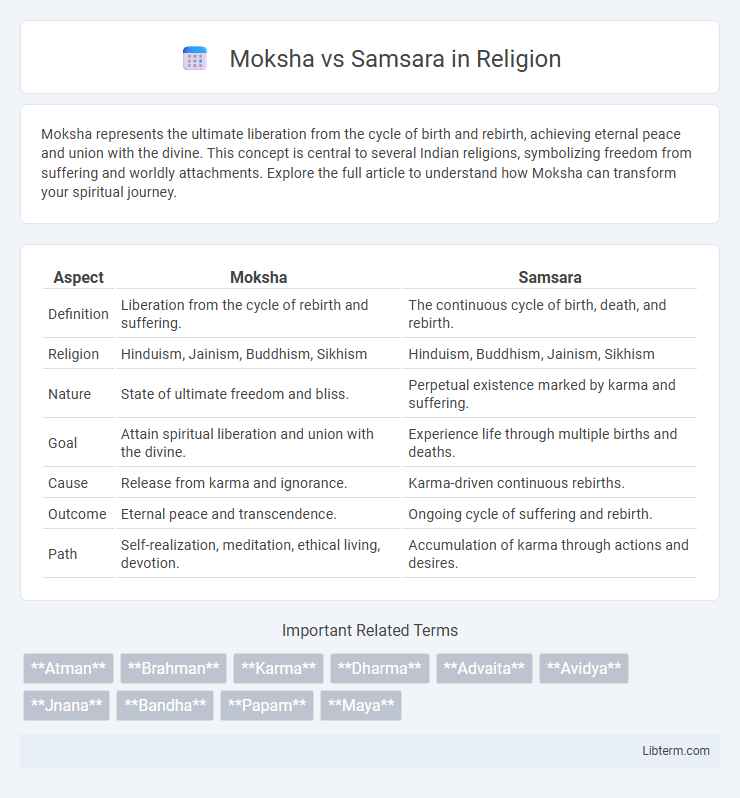Moksha represents the ultimate liberation from the cycle of birth and rebirth, achieving eternal peace and union with the divine. This concept is central to several Indian religions, symbolizing freedom from suffering and worldly attachments. Explore the full article to understand how Moksha can transform your spiritual journey.
Table of Comparison
| Aspect | Moksha | Samsara |
|---|---|---|
| Definition | Liberation from the cycle of rebirth and suffering. | The continuous cycle of birth, death, and rebirth. |
| Religion | Hinduism, Jainism, Buddhism, Sikhism | Hinduism, Buddhism, Jainism, Sikhism |
| Nature | State of ultimate freedom and bliss. | Perpetual existence marked by karma and suffering. |
| Goal | Attain spiritual liberation and union with the divine. | Experience life through multiple births and deaths. |
| Cause | Release from karma and ignorance. | Karma-driven continuous rebirths. |
| Outcome | Eternal peace and transcendence. | Ongoing cycle of suffering and rebirth. |
| Path | Self-realization, meditation, ethical living, devotion. | Accumulation of karma through actions and desires. |
Understanding Moksha: The Ultimate Liberation
Moksha, in Hindu philosophy, signifies the ultimate liberation from Samsara, the endless cycle of birth, death, and rebirth driven by karma and desires. Achieving Moksha involves realizing the self's unity with Brahman, the supreme universal consciousness, leading to freedom from worldly suffering and spiritual ignorance. This liberation marks the soul's transcendence beyond physical existence, ending the perpetual cycle of reincarnation.
Defining Samsara: The Cycle of Birth and Rebirth
Samsara refers to the continuous cycle of birth, death, and rebirth driven by karma and desires in Hinduism, Buddhism, and Jainism. This cycle traps souls in worldly suffering until they attain spiritual liberation. Understanding Samsara involves recognizing the impermanence of life and the ongoing process of reincarnation shaped by one's actions and intentions.
Core Philosophical Differences
Moksha represents liberation from the cycle of Samsara, which is the continuous process of birth, death, and rebirth driven by karma. Samsara is characterized by suffering and attachment, whereas Moksha embodies freedom, self-realization, and union with ultimate reality. The core philosophical difference lies in Moksha being the ultimate goal of spiritual practice to transcend Samsara's impermanence and achieve eternal bliss.
Origins in Hindu and Buddhist Thought
Moksha originates in Hindu philosophy as the liberation from samsara, the cycle of birth, death, and rebirth, achieved through self-realization and union with Brahman. Samsara, foundational in both Hinduism and Buddhism, represents the continuous cycle of suffering and rebirth influenced by karma. In Buddhism, the concept of Nirvana parallels Moksha but emphasizes the cessation of desire and ignorance, highlighting a distinct approach to escaping samsara.
The Role of Karma in Moksha and Samsara
Karma plays a crucial role in determining one's journey through Samsara, the continuous cycle of birth, death, and rebirth, by influencing the circumstances and experiences of each life based on past actions. Moksha represents the liberation from Samsara, achieved when accumulated karma is fully resolved, allowing the soul to transcend worldly existence and attain spiritual freedom. The purification of karma through righteous actions and spiritual practices is essential for breaking Samsara's cycle and realizing Moksha.
Paths to Attain Moksha
Paths to attain Moksha commonly include the Jnana Yoga (path of knowledge), Bhakti Yoga (path of devotion), Karma Yoga (path of selfless action), and Raja Yoga (path of meditation). Jnana Yoga involves deep philosophical inquiry and realization of the self's unity with Brahman, while Bhakti Yoga emphasizes devotion to a personal deity such as Vishnu or Shiva. Karma Yoga focuses on performing duties without attachment to outcomes, and Raja Yoga incorporates meditation and disciplined practices outlined in Patanjali's Yoga Sutras to transcend the cycle of Samsara.
The Trappings of Samsara: Earthly Attachments and Suffering
The trappings of Samsara describe the cycle of birth, death, and rebirth bound by earthly attachments and desires, leading to inevitable suffering and ignorance. These attachments create karmic debts that perpetuate the soul's entanglement in material existence and emotional turmoil. Liberation, or Moksha, is achieved by transcending these illusions, dissolving desires, and realizing the true self beyond the transient physical world.
Moksha in Different Eastern Traditions
Moksha represents the liberation from the cycle of Samsara, or rebirth, and is central to Hinduism, Buddhism, and Jainism, each interpreting it uniquely. In Hinduism, Moksha signifies union with Brahman, the ultimate reality, achieved through self-realization and detachment from material desires. Buddhism views Moksha as Nirvana, the cessation of suffering and release from karmic cycles, while Jainism emphasizes complete purification of the soul to attain infinite bliss and knowledge, escaping Samsara's perpetual bondage.
Impact of Moksha and Samsara on Daily Life
Moksha represents liberation from the cycle of Samsara, profoundly influencing daily life by fostering detachment from material desires and promoting inner peace. Samsara, characterized by continuous birth, death, and rebirth, drives individuals to experience suffering and attachment, shaping behaviors and motivations. Pursuing Moksha encourages ethical living, mindfulness, and spiritual growth, whereas Samsara's impact often leads to fluctuating emotions and a focus on transient worldly achievements.
Moksha vs Samsara: Key Takeaways and Reflections
Moksha represents liberation from the cycle of Samsara, the endless process of birth, death, and rebirth driven by karma and desires. Achieving Moksha means attaining spiritual freedom, self-realization, and eternal bliss, while Samsara embodies worldly suffering and attachment. The key takeaway lies in transcending material existence through ethical living, meditation, and self-knowledge to break free from Samsara and reach Moksha.
Moksha Infographic

 libterm.com
libterm.com